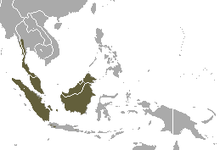Banded linsang
| Banded linsang | |
|---|---|

| |
| Scientific classification | |
| Domain: | Eukaryota |
| Kingdom: | Animalia |
| Phylum: | Chordata |
| Class: | Mammalia |
| Order: | Carnivora |
| Suborder: | Feliformia |
| Family: | Prionodontidae |
| Genus: | Prionodon |
| Species: | P. linsang[1]
|
| Binomial name | |
| Prionodon linsang[1] (Hardwicke, 1821)
| |

| |
| Banded linsang range | |
The banded linsang (Prionodon linsang) is a
Description
The banded linsang grows to 35–41.1 cm (13.8–16.2 in), with a long tail that can reach 36.2 cm (14.3 in).[3] It is a pale yellow with five dark bands. The average weight is around 700 g (25 oz). It has broad stripes on its neck and its tail consists of several dark bands with a dark tip. The tail has seven or eight dark bands and ends in a dark tip. The banded linsang has very sharp retractable claws.[4]
Distribution and habitat
The banded linsang has been recorded in southern
In 2013, a banded linsang was recorded for the first time by a camera-trap in the hill forests of
Ecology and behaviour
The banded linsang is
Very little is known about the banded linsang's reproduction. It is thought that litters of 2–3 are born semiannually in a nest in burrows or hollow trees.[7]
Taxonomy
Until recently the two species of Asiatic linsangs were considered to be members of the family
References
- OCLC 62265494.
- ^ . Retrieved 24 January 2022.
- ^ a b "Banded Linsang". Wildlife Conservation Society Indonesia. Retrieved 12 February 2019.
- ^ "Prionodon linsang - banded linsang". Anmial Diversity Web.
- .
- S2CID 17396993.
- ISBN 978-0-02-627680-1.
External links
- Banded linsang media from ARKive

